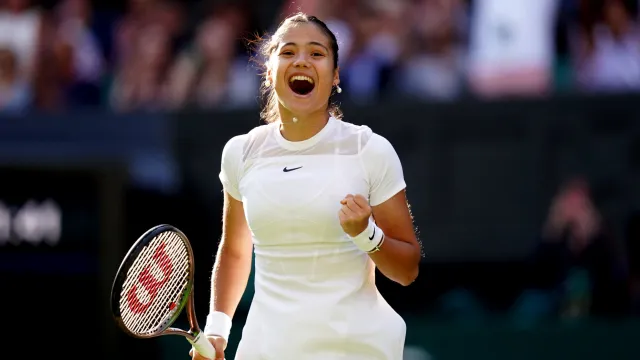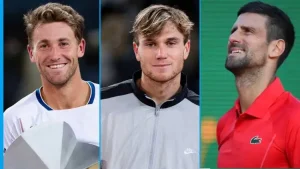
The 2021 US Open champion has skipped Roland Garros to focus on fitness ahead of her first grass-court campaign in two years
Emma Raducanu has a plan, a plan that if it works will re-establish her as the darling of British tennis.
If it fails, she will have skipped one of the four biggest events in tennis for nothing.
Success, ultimately, would be winning Wimbledon. But a return to the second week would be enough to justify her shunning of the French Open.
Emma Raducanu, 22, pulled out of the clay-court major last week. She had requested a wildcard after failing to qualify for the tournament on ranking but missed out – all six available went to French players – and did not choose to play the qualifying event.
“It’s important for me to keep laying on the foundations and I will use the time to do a healthy block before the grass and subsequent hard court seasons to give myself a chance to keep fit for the rest of the year,” she said in a statement.
There was no mention of an injury. The suspicion is she was worried about being schooled again as she was by little-known Maria Lourdes Carle in Madrid.
“I think she was probably hoping that she was just going to get straight into the main draw,” Tim Henman, a French Open semi-finalist, tells i.
“If she just wants to continue to build fitness, and then get ready for the grass, then that’s her prerogative. I wouldn’t read too much into it.
“I think she’s played some great tennis on clay, Billie Jean King Cup and Stuttgart. But she’s going to be even better on on grass so I would be focusing on that.”
Raducanu has already announced she will play Nottingham, the WTA tournament that starts the day after the French Open on 10 June. She is entered in Birmingham the week after, but will need a wildcard to get in, while Eastbourne the week before Wimbledon is also an option. She is extremely unlikely to play all three, understandably cautious not to overload 12 months on from breaking down with injuries that required three surgeries. Instead, she will work with coach Nick Cavaday and Britain’s head of women’s tennis Iain Bates, as well as the LTA’s army of fitness and conditioning staff, to peak at exactly the right time.
The intention will be to produce her best tennis at Wimbledon, the tournament where she made her breakthrough three years ago by reaching the fourth round. Raducanu’s days involve double gym sessions and double tennis sessions, having moved from hard-court work to grass this week.
In that sense, there is a kind of logic to skipping three weeks of clay-court tennis, the surface that is the least like the slick grass courts of Wimbledon.
But British No 1 Katie Boulter would not agree. In fact, she believes her work on the red dirt, where she has only played five tour-level matches in her whole career, is making her a better player overall.
“[Clay] is a bit of a leveller. You can’t really get any cheap points here and there,” Boulter said.
“So a lot of my weapons can be equalised and I have to find different ways and more creative ways of actually winning matches.
“But I actually think it’s great for me because that will really help me on a hard court and on a grass court.
“Ultimately, if you look at the players that have won these tournaments, you look at Serena [Williams], you look at [Maria] Sharapova, you look at these girls like [Elena] Rybakina, all of them, they’re all big hitters and going after it.
“That’s a really good lesson for me to remind myself that I have a game to win on these courts. It’s just a matter of putting that on the court.”
Henman too, whose serve-and-volley style could not have been less suited to clay, relished the challenge of improvement on the surface and insists he never considered skipping Roland Garros
“I knew that if I did play well on clay, then it would make the other surfaces much easier,” adds Henman, now a pundit on Eurosport and discovery+, the home of the French Open in the UK.
“But just the work, the practice, the matches, the movement… it’s a great foundation and so I always enjoyed the clay court season.
“And inevitably, I think my expectations were a little bit less and so therefore I felt there was kind of nothing to lose and everything to gain.
“When I reflect on making the semis in Monte Carlo or making the semis of the French and some of the people I beat – Albert Costa, French Open champion, Gaston Gaudio, French Open champion – I beat a lot of good players on clay.”
Emma Raducanu has a couple of scalps too on the surface. She won four matches in a row to start her clay season this year, the best against Caroline Garcia, then ranked No 23, before turning up to Madrid, complaining of the “brutal” nature of the tour and heading home for what turned out to be more than a month without a tournament.
It leaves British representation at the French Open, in the women’s draw, particularly meagre.
Jodie Burrage, who did get in on direct entry, is on crutches and in a protective boot, awaiting scan results on an ankle she twisted in practice. Harriet Dart did at least make the start line but will play No 27 Linda Noskova and is a significant underdog. Boulter, seeded, has drawn former world No 2 Paula Badosa.
The inquest may start as soon as Tuesday, when Raducanu’s absence in Paris will be even more keenly felt.
But all will be forgiven if she goes well at Wimbledon. That’s the plan – but plans rarely survive contact with the enemy.





